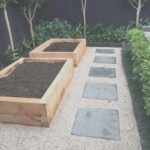With the growing popularity of gardening, many people are turning to innovative methods to create their own vegetable gardens. One rising trend is the use of concrete blocks as raised beds or borders. However, there are concerns about whether concrete blocks are safe for growing edible plants. In this blog post, we will delve into the safety of using concrete blocks in vegetable gardens and address the potential risks and benefits associated with this practice.
The use of concrete blocks in gardening has gained traction due to their affordability, durability, and ease of use. They provide a convenient solution for creating raised beds or garden structures quickly and efficiently. However, it is crucial to consider the safety implications when using these materials in close proximity to edible crops.
Throughout this article, we will explore the composition of concrete blocks and assess any potentially harmful substances that may be present. We will also discuss the potential risks associated with using concrete blocks in vegetable gardens, such as chemical leaching into the soil or heat retention that can harm plant roots. Additionally, we will examine the environmental impact of concrete block production and offer eco-friendly alternatives.
Stay tuned as we provide tips for ensuring safety when using concrete blocks in your vegetable garden. We will recommend best practices for limiting potential risks and guide you on proper installation techniques. Moreover, we will highlight success stories from gardeners who have used concrete blocks, providing valuable insights and lessons learned.
Before making any decisions for your vegetable garden, it is essential to consider both the advantages and disadvantages of using concrete blocks. By weighing the pros and cons outlined in this article and considering your individual gardening needs and preferences, you can make an informed choice about whether or not to incorporate concrete blocks into your vegetable garden setup.
Continue reading to gain a comprehensive understanding of the safety implications involved when using concrete blocks in vegetable gardens.
Understanding the Composition of Concrete Blocks
Concrete blocks are commonly used in vegetable gardens due to their durability and ease of use. However, before utilizing concrete blocks in your garden, it is important to understand their composition and potential impact on plant health and soil quality.
Concrete blocks are typically made from a combination of cement, aggregates (such as sand or gravel), and water. Cement is a binder that holds the aggregate materials together, forming a solid structure. While the primary components of concrete blocks are generally safe for plants, there may be potential concerns regarding other substances present in the blocks.
One potential concern is the presence of heavy metals in the aggregates used to manufacture concrete blocks. These metals can include lead, arsenic, cadmium, and chromium, which may pose risks to both plant health and human consumption. The leaching of these metals into the soil can occur over time, especially if the concrete blocks are in direct contact with the soil.
It is also important to consider any additives or admixtures that may have been used during the production of concrete blocks. Some common additives include fly ash or slag, which are byproducts of industrial processes. These materials may contain trace elements or toxins that could potentially affect plant growth and development.
To ensure the safety of your vegetable garden when using concrete blocks, it is advisable to source blocks from reputable suppliers who can provide information on the composition and any harmful substances present. Additionally, employing measures such as lining the inside of each block with food-grade plastic or organic materials can help create a barrier between the soil and any potentially harmful substances within the block.
Assessing the Potential Risks to Vegetable Gardens
Concrete blocks have gained popularity in vegetable gardening due to their durability and ease of use. However, it is important to understand the potential risks associated with using concrete blocks in vegetable gardens. By assessing these risks, gardeners can take necessary precautions to ensure the safety of their plants and soil.
One potential risk is the leaching of chemicals into the soil. Concrete blocks are made up of various materials such as cement, aggregates, and sometimes additives. These materials can contain potentially harmful substances like heavy metals or pollutants. When these materials come into contact with water or moisture from the soil, they may leach into the surrounding soil and ultimately affect the health of plants.
To minimize this risk, gardeners should consider using concrete blocks that are specifically designed for gardening purposes. These blocks are often made without additives that could potentially harm plants and vegetation. Additionally, avoiding painted or sealed concrete blocks can also reduce the risk of chemical leaching into the soil.
Another concern is heat retention and its impact on plant roots. Concrete has a high thermal mass, meaning it absorbs and retains heat. In hot climates or during summer months, this heat retention can potentially cause damage to plant roots by overheating them.
To mitigate this risk, gardeners should consider creating a barrier between the concrete blocks and plant roots. Placing a layer of insulation material such as foam or landscape fabric between the concrete block and soil can help regulate soil temperature and protect plant roots from excessive heat exposure.
The Environmental Impact of Concrete Blocks in Vegetable Gardens
In recent years, there has been a growing trend of using concrete blocks in vegetable gardens. These blocks offer several advantages such as easy installation, durability, and versatility. However, it is important to consider the potential environmental impact of using concrete blocks in gardening.
Concrete blocks are made from a combination of cement, aggregate (such as sand or gravel), and water. Cement production is known to have a significant carbon footprint, contributing to greenhouse gas emissions. According to the International Energy Agency, cement production accounted for 8% of global CO2 emissions in 2019. This raises concerns about the sustainability aspect of using concrete blocks in vegetable gardens.
One way to address this concern is by exploring alternatives to traditional concrete blocks that may be more eco-friendly. For example, some manufacturers produce concrete blocks with recycled materials or use greener cement substitutes like fly ash or slag. These alternative options can help reduce the environmental impact associated with concrete block production.
| Environmental Impact | Data |
|---|---|
| Total CO2 emissions from cement production in 2019 | 2.8 billion tons |
| Percentage contribution of cement production to global CO2 emissions in 2019 | 8% |
While there are concerns regarding the environmental impact of using concrete blocks in vegetable gardens, it is crucial to weigh these factors against other benefits they offer. In the next section, we will discuss tips for ensuring safety when using concrete blocks and explore their advantages and potential risks further. By considering all aspects – environmental impact included – gardeners can make informed decisions for their vegetable gardens that align with their individual values and preferences.
Tips for Ensuring Safety when Using Concrete Blocks in Vegetable Gardens
Preventing Chemical Leaching
When using concrete blocks in vegetable gardens, it is important to take precautions to prevent the leaching of chemicals into the soil. One way to do this is by sealing the blocks before using them in your garden.
Applying a non-toxic sealant or paint on the inner side of the blocks can create a barrier that prevents any potential harmful substances from seeping into the soil. It is crucial to ensure that the sealant or paint used is safe for use in vegetable gardens and does not contain any toxic ingredients.
Another method to limit chemical leaching is by lining the inside of the blocks with a protective barrier such as landscape fabric. This fabric acts as an additional layer of protection between the blocks and the soil, preventing any potential contact and absorption of harmful substances. Be sure to use a fabric that is specifically designed for gardening purposes and known for its ability to prevent chemical transfer.
Proper Installation and Spacing
To ensure safety and maximize plant health, proper installation and spacing of concrete blocks in vegetable gardens are essential. When setting up your raised bed or garden area, make sure to correctly level and align the blocks so that they form a stable structure. This will help maintain their integrity over time.
Additionally, consider leaving enough space between each block for adequate air circulation. Airflow is crucial for preventing excessive heat retention in concrete blocks, which can potentially harm plant roots. By providing sufficient distance between each block, you allow for better ventilation, reducing the risk of overheating.
Maintaining Soil pH Balance
Concrete blocks may have an impact on soil pH levels due to their alkaline nature. It is important to regularly monitor and adjust soil acidity if necessary when using concrete blocks in your vegetable garden. This can be done by performing regular soil tests and making amendments accordingly.
If your soil becomes too alkaline as a result of using concrete blocks, you can lower the pH by adding organic matter such as compost or peat moss. These amendments help balance the pH and create a more favorable environment for the growth of your vegetable plants.
By following these tips for ensuring safety when using concrete blocks in vegetable gardens, you can minimize potential risks and create a healthy environment for your plants to thrive. It is always important to remember that each garden is unique, and factors such as climate, soil type, and specific plant requirements should be taken into consideration when making decisions regarding the use of concrete blocks.
Considering the Benefits of Using Concrete Blocks in Vegetable Gardens
Concrete blocks have become increasingly popular in vegetable gardens due to their numerous benefits. These versatile building materials offer advantages that can enhance the overall gardening experience. Understanding the benefits of using concrete blocks can help gardeners make an informed decision about whether they are a suitable choice for their vegetable gardens.
Durability and Longevity
One significant advantage of concrete blocks is their durability and longevity. Unlike wood or other organic materials, concrete blocks are resistant to rot, pests, and weathering. This means that once installed, they can last for many years without requiring replacement or maintenance. With proper care, concrete blocks can withstand harsh environmental conditions and retain their structural integrity, ensuring the longevity of your vegetable garden setup.
Ease of Use
Concrete blocks are also known for their ease of use. They are designed to be modular, making them easy to stack and arrange in various configurations to suit individual gardening needs. Whether you’re planning raised beds, retaining walls, or borders, concrete blocks provide a simple solution that requires minimal tools and time. Additionally, the uniform shape and size of concrete blocks make installation straightforward, even for novice gardeners.
Versatility
Another benefit of using concrete blocks in vegetable gardens is their versatility. These solid units can be used for a wide range of purposes beyond traditional raised beds. They can serve as seating areas when stacked together at appropriate heights or act as partitions to separate different types of plants in the garden. With creativity and imagination, gardeners can explore different ways to incorporate concrete blocks into their layout design.
Case Studies
Concrete blocks have become a popular choice for vegetable gardeners due to their versatility and durability. Many gardeners have shared their real-life experiences with using concrete blocks, shedding light on the benefits and challenges associated with this gardening method.
One successful case study comes from Jane, a gardener who used concrete blocks to create raised beds for her vegetable garden. She found that the blocks provided excellent support and structure for her plants. The raised beds were easy to maintain and allowed for better control over soil quality and drainage. Additionally, Jane mentioned that the concrete blocks helped deter pests, as they acted as a barrier between her plants and potential invaders.
However, it is important to note that some gardeners have faced challenges when using concrete blocks in their vegetable gardens. Michael encountered an issue with heat retention in his raised bed made of concrete blocks. The blocks absorbed heat during hot summer days and retained it well into the evening, which created stressful conditions for his plants. In order to mitigate this issue, Michael began covering the exposed sides of the concrete blocks with shade cloth during peak temperatures.
These case studies emphasize the importance of considering individual gardening needs and preferences when deciding whether or not to use concrete blocks in a vegetable garden. While many gardeners have successfully incorporated concrete blocks into their gardening practices, it is essential to be aware of potential challenges such as heat retention. By learning from these real-life experiences, individuals can make informed decisions about whether or not to use concrete blocks in their own vegetable gardens.
- Case Study 1: Jane’s Success with Concrete Blocks
- Case Study 2: Michael’s Challenge with Heat Retention
Conclusion
The safety of using concrete blocks in vegetable gardens is a topic of concern for many gardeners. While concrete blocks offer durability and ease of use, it is important to weigh the potential risks and benefits before deciding to incorporate them into your garden.
In this article, we have explored the composition of concrete blocks, assessed the potential risks they may pose to vegetable gardens, discussed their environmental impact, provided tips for ensuring safety when using them, and highlighted the advantages they offer.
Ultimately, making an informed decision for your vegetable garden requires considering your individual gardening needs and preferences. It is important to assess the composition of concrete blocks and determine if any potential harmful substances are present. Understanding the impact these materials may have on plants and soil is crucial for maintaining a safe environment for your vegetables.
Furthermore, it is necessary to assess the potential risks associated with using concrete blocks in vegetable gardens. One major concern is the leaching of chemicals into the soil, which can have detrimental effects on plant health. It is essential to take precautions to prevent chemical leaching by using a barrier between the block and soil or opting for alternative materials that do not pose this risk.
Installing concrete blocks properly and spacing them appropriately also plays a significant role in ensuring safety in your vegetable garden. Following best practices can help mitigate heat retention issues and prevent harm to plant roots.
| Section | Content |
|---|---|
| Introduction | – Explanation of the rising trend of using concrete blocks in gardening
|
| Understanding the Composition of Concrete Blocks | – In-depth explanation of the materials used in concrete blocks
|
| Assessing the Potential Risks to Vegetable Gardens | – Identifying potential risks associated with using concrete blocks in vegetable gardens
|
Additional Resources and References
In conclusion, when it comes to using concrete blocks in vegetable gardens, it is important to consider both the potential risks and benefits. While concrete blocks can provide durability, ease of use, and versatility for gardeners, there are also concerns about the composition of these blocks and their potential impact on plants and soil. Understanding the materials used in concrete blocks and being aware of their potential risks is crucial.
To ensure safety when using concrete blocks in vegetable gardens, there are several best practices that can be followed. These include preventing chemical leaching into the soil by using a protective barrier such as a geotextile fabric, properly installing and spacing the blocks to avoid heat retention and harm to plant roots, and regularly monitoring plants for any signs of distress or nutrient deficiencies.
It is also important for gardeners to carefully weigh the pros and cons before deciding whether to use concrete blocks in their vegetable gardens. Considering individual gardening needs and preferences is key, as some gardeners may prioritize durability and longevity while others may prioritize sustainability and eco-friendliness.
For further information on this topic, there are additional resources and references available. These include research papers, professional opinions, relevant websites or organizations focused on sustainable gardening, as well as related blog posts or articles that offer a more comprehensive knowledge on the subject.
Frequently Asked Questions
Are cinder blocks safe to grow vegetables in?
Cinder blocks can be safe for growing vegetables, depending on certain factors. While cinder blocks are strong and durable, they may contain harmful substances like coal fly ash or heavy metals that could leach into the soil over time.
These substances could potentially be taken up by the plants and pose a risk to human health when consumed. To mitigate this risk, it is recommended to line the interior of the cinder blocks with food-grade polyethylene plastic or use a raised bed liner to create a barrier between the soil and the cinder blocks.
Is it safe to grow vegetables in concrete?
Growing vegetables in concrete can be safe as long as proper precautions are taken. Concrete itself is generally inert and does not leach harmful substances into the soil. However, if the concrete contains additives like sealants or coatings that may contain toxic substances, these could potentially transfer to the soil and plants.
It is important to ensure that any additives used in or on the concrete are safe for growing edible plants. Additionally, drilling drainage holes in the bottom of concrete containers or using raised beds with a layer of gravel for drainage can help prevent waterlogging and promote healthy plant growth.
Are bricks safe for vegetable gardens?
Bricks can be a relatively safe material for vegetable gardens if used correctly. Bricks themselves are typically free from harmful substances that could contaminate soil or plants when used in garden beds or containers. However, without proper preparation, bricks can sometimes release salts into the soil as they weather over time, which may affect plant health.
To prevent this potential issue, it is advisable to thoroughly clean bricks before using them in vegetable gardens and avoid using salt-based mortars during construction. Creating proper drainage systems within brick structures and regularly monitoring pH levels and soil quality can also help ensure a safe environment for growing vegetables in brick gardens.

If you’re looking to get into vegetable gardening, or are just looking for some tips on how to make your current garden better, then you’ve come to the right place! My name is Ethel and I have been gardening for years. In this blog, I’m going to share with you some of my best tips on how to create a successful vegetable garden.





